January 2025
The global medical supplies and labware market size is calculated at USD 212.09 billion in 2025 and is forecasted to reach around USD 318.30 billion by 2034, accelerating at a CAGR of 4.61% from 2025 to 2034. The North America market size surpassed USD 78.60 billion in 2024 and is expanding at a CAGR of 3.90% during the forecast period. The market sizing and forecasts are revenue-based (USD Million/Billion), with 2024 as the base year.
The global medical supplies and labware market size was estimated at USD 204 billion in 2024 and is predicted to increase from USD 212.09 billion in 2025 to approximately USD 318.30 billion by 2034, expanding at a CAGR of 4.61% from 2025 to 2034. The ongoing innovative product launches, growing demand for automated and streamlined workflow platforms, and expanding healthcare infrastructure are the factors fostering the growth of the market.
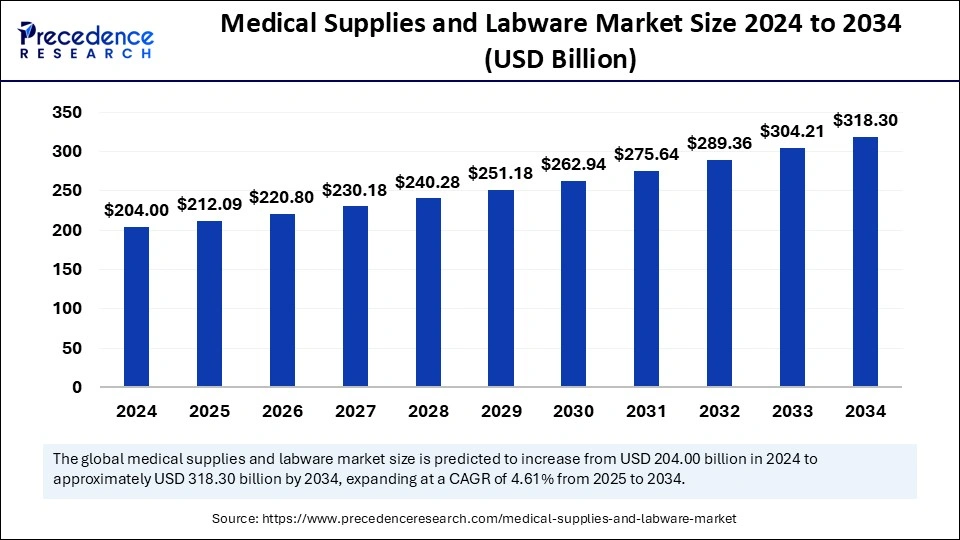
The integration of Artificial Intelligence in the medical supplies and labware market is transforming the healthcare sector by improving the accuracy and efficiency of workflows, further enhancing patient safety and care with minimized costs. Furthermore, AI can be incorporated for designing labware and development of medical supplies with improved functionality as well as for optimization of supply chain management with effective inventory management and use of predictive analytics for forecasting demand.
AI can be applied for various applications such as automating tasks, for detection of anomalies in medical images such as X-rays and CT (Computed Tomography) scans for early disease detection, in biomarker analysis, development of personalized treatment strategies, for providing clinical decision support allowing clinicians to make informed decisions and also in streamlining manufacturing processes leading enhanced compliance with regulatory standards and production yield.
The U.S. medical supplies and labware market size was exhibited at USD 66.69 billion in 2024 and is projected to be worth around USD 95.14 billion by 2034, growing at a CAGR of 3.60% from 2025 to 2034.
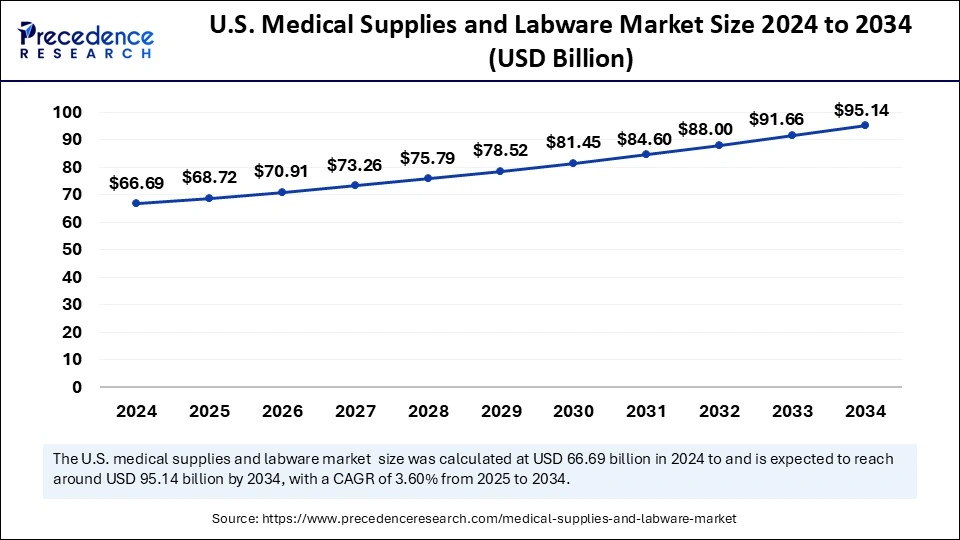
North America dominated the global medical supplies and labware market with the largest share in 2024. The market dominance of this region can be attributed to the presence of advanced healthcare infrastructure, increased focus on preventive care, major market players heavily investing in research activities and development of innovative technologies, growing demand for sustainable products with improved functionality, and support from government authorities. Key regional players like the U.S., Canada, and Mexico contribute to the region’s growth.
U.S. dominated the North American medical supplies and labware market with the largest share in 2024. The increased healthcare expenditure, demand for precision medicine, increased R&D activities in life science industries, ongoing advancements in laboratory technology, rising disposable incomes, and growing adoption of clinical diagnostic testing are the factors driving the market growth. Moreover, government agencies such as the Food and Drug Administration (FDA) and the Defence Logistics Agency (DLA) oversee the regulation and procurement of medical supplies and labware while ensuring their safety and efficacy.
Asia Pacific is anticipated to witness lucrative growth in the medical supplies and labware market during the forecast period. The rising investments by developing countries for advancing healthcare infrastructure, increased chronic disease burden and aging population, diverse demographics suitable for conducting clinical trials, emerging markets in India and China, various government initiatives, surge in diagnostic testing and increased investments for R&D activities are the factors expected to boost the market growth of this region in the upcoming years.
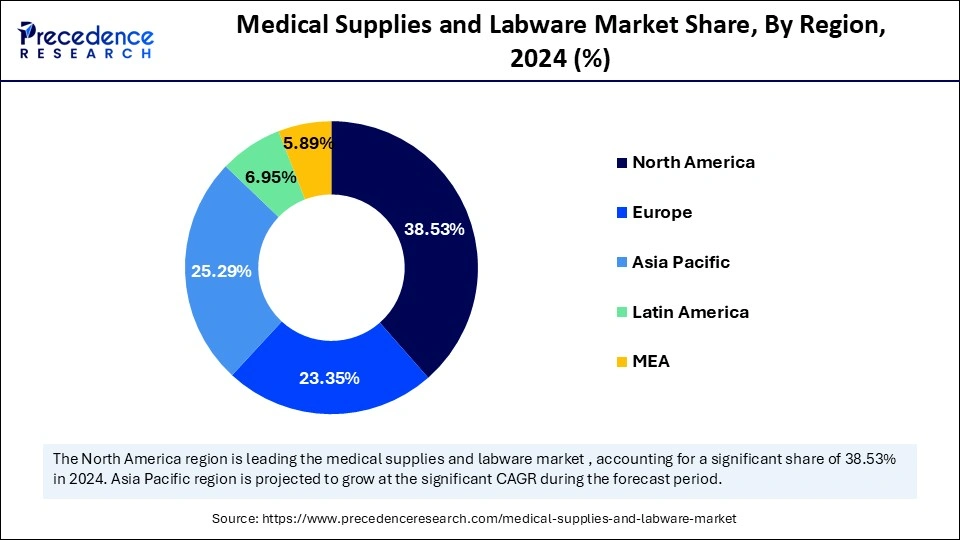
China is expected to grow at the fastest rate in the Asia Pacific medical supplies and labware market, owing to the rising innovations in healthcare technology, highly developed healthcare infrastructure, and the presence of skilled labour. Furthermore, the Made in China 2025 initiative, led by the Chinese government to support domestic manufacturing in the biopharmaceutical industry and attract foreign investment,s is driving the market growth.
Europe is expected to grow significantly in the medical supplies and labware market in the upcoming years. The market growth is driven by the presence of robust research and manufacturing infrastructure, rising geriatric population, demand for advanced diagnostics tools and medical devices, supportive regulatory framework, and initiatives for sustainable development by governments in the region.
Germany is predicted to witness notable growth in the medical supplies and labware market. The strong presence of medical technology companies, implementation of precision engineering and quality manufacturing practices, digital health initiatives by the government, favourable regulatory environment, and strong healthcare system fuel the market growth.
Medical supplies refer to items utilized for medical purposes such as disposable or semi-disposable tools, materials, and equipment which is designed and applied for diagnosis, treatment, and prevention of injury or illnesses in different settings, such as healthcare facilities and home care. Labware is the general glassware and other equipment that is extensively used in several types of laboratories, eliminating specialized instruments like microscopes, spectrometers. Labware is produced from various materials like borosilicate glass, metals, plastics like polypropylene or PTFE (polytetrafluoroethylene), and ceramics.
The ongoing advancements in medical technologies, the adoption of advanced healthcare infrastructure in emerging economies, and increased research activities for developing novel therapies and treatments are driving the demand for the medical supplies and labware market across the globe. Furthermore, there is an increased adoption of advanced medical equipment and tools, a growing demand for personalized treatments, a surge in R&D activities, an expansion of the biopharmaceutical sector, ongoing clinical trials, and innovative product launches by manufacturers to keep up with changing consumer needs.
| Report Coverage | Details |
| Market Size by 2034 | USD 318.30 Billion |
| Market Size in 2025 | USD 212.09 Billion |
| Market Size in 2024 | USD 204 Billion |
| Market Growth Rate from 2025 to 2034 | CAGR of 4.61% |
| Dominating Region | North America |
| Fastest Growing Region | Asia Pacific |
| Base Year | 2024 |
| Forecast Period | 2025 to 2034 |
| Segments Covered | Type, Material, Application, End User, and Regions. |
| Regions Covered | North America, Europe, Asia-Pacific, Latin America, and Middle East & Africa. |
Increased demand and effective marketing strategies
Medical supply and labware manufacturing companies are continuously employing several market penetration strategies such as implementation of digital marketing tools like SEO (Search Engine Optimization) of company’s website for driving organic traffic and enhancing visibility, identifying and building relationships with key opinion leaders (KOL) in the industry for product promotion, deploying attractive pricing strategies, opening new distribution channels, focusing on strategic alliance and acquisitions for expanding presence in the competitive market, setting up go-to-market (GTM) strategies for expanding product portfolios, integration of Internet of Things (IoT) technology and exploiting post-sales survey and customer feedbacks for enhancing product sales and gaining market share.
High costs and supply chain disruptions
The manufacturing of medical supplies and labware requires high initial capital investments for developing facilities with advanced production capacities while navigating the complex regulatory requirements, making them unaffordable for several small-scale and mid-sized organizations as well as academic institutions and laboratories in developing economies, further restraining the market growth. Moreover, high production costs, scarcity of raw materials, and shortage of skilled labor to cater to the increased demand across the globe can lead to disruptions in supply chains, hampering market growth.
Initiatives for scientific sustainability
Various governments, manufacturers, and global organizations are taking initiatives to develop eco-friendly products for medical use that can be recycled to create a sustainable future. Companies are developing novel solutions for producing bio-based medical consumables with enhanced performance and reliability. Furthermore, the optimization of resource consumption, the development of sustainable laboratory designs, circular lab waste initiatives, and the donation of used laboratory equipment to researchers and academic institutes are creating opportunities for market growth.
The medical supplies segment dominated the market with the largest share in 2024. Medical supplies are used for various applications in clinical as well as non-clinical settings, making them an essential commodity. The rising disease burden, increased expenditure by emerging economies for the adoption of advanced healthcare infrastructure, ongoing developments in medical technology, a growing number of injuries and accidents, and increasing disposable incomes. Initiatives and policies led by global organizations, emerging economies, and other establishments for supplying medical stock to several low and middle-income countries (LMICs) as well as nations experiencing conflict is boosting the demand and driving the market growth of this segment.
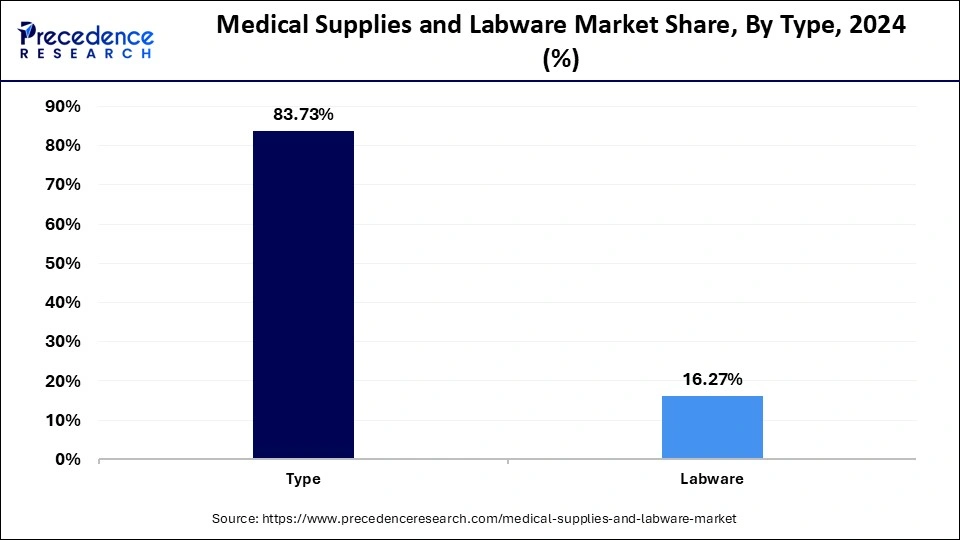
Under the medical supplies segment, the disposable products sub-segment holds a significant share of the market. The market growth is driven by the rising demand for emergency medical supplies and single-use disposable medical products, increased research on developing innovative sterilization techniques, expanding healthcare infrastructure, huge numbers of ongoing clinical trials, increased emphasis on preventing nosocomial infections, and the development of environment-friendly medical disposables. Companies are heavily investing in adopting advanced technologies for expanding product portfolios and also for implementing current Good Manufacturing Practices (cGMP) to maintain adherence with stringent regulations and product quality, as well as for ensuring patient safety, further mitigating risks associated with product recalls and financial losses.
The labware segment is expected to grow at a notable rate during the forecast period. The surging cases of infectious and chronic diseases creating demand for advanced diagnostic procedures, growing number of clinical and research laboratories, increased use in laboratory settings for ensuring accuracy and reliability in quality control processes, increased focus on preventive care and rising investments for automating and digitalization laboratory processes are the factors driving the market growth of this segment.
Medical Supplies and Labware Market Revenue, By Type 2022-2024 (USD Billion)
| Type | 2022 | 2023 | 2024 |
| Medical Supplies | 159.44 | 164.92 | 170.81 |
| Labware | 28.65 | 30.05 | 31.57 |
The plastic segment will capture the largest share of the medical supplies and labware market in 2024. The market growth is driven by the increased focus on using single-use and disposable plastic devices for preventing cross-contamination in healthcare applications, availability of cost-effective plastic labware and supplies, improved compatibility with different sterilization methods like gamma radiation, enhanced user convenience and surging demand for antimicrobial plastics for minimizing risks of healthcare-associated infections (HAIs). Ongoing advancements in material science with development of innovative polymers offering enhanced biocompatibility and chemical resistance in plastic labware and medical devices, increased R&D activities, complexity of medical devices creating demand for specialized plastics and growing awareness towards environmental issues driving novel research initiatives for sustainable solutions such as development of plant-derived plastic labware are the factors fostering the market growth of this segment.
The metal segment is anticipated to grow at the fastest rate during the forecast period. Metals such as stainless steel, copper, titanium, cobalt-chrome, aluminium, gold, platinum, tantalum, and iridium, among others, are extensively used in medical supplies and labware owing to their desirable properties, such as corrosion resistance, biocompatibility, strength, durability, sterilization compatibility, and ease of fabrication. The growing demand for specialized metal instruments and devices for minimally invasive procedures and surgeries, development of advanced additive manufacturing techniques like 3D printing enabling the creation of highly complex and customized metal devices and implants, application of metal implants for dental and orthopaedic procedures, innovations such as medical metal tubing and utilization of specific metal alloys such as nitinol and cobalt-chromium alloys in medical devices due to their unique properties.
Medical Supplies and Labware Market Revenue, By Material, 2022-2024 (USD Billion)
| Material | 2022 | 2023 | 2024 |
| Plastic | 75.56 | 78.98 | 82.65 |
| Glass | 50.31 | 51.69 | 53.17 |
| Metal | 30.59 | 31.72 | 32.93 |
| Ceramic | 17.00 | 17.49 | 18.02 |
| Others | 16.03 | 16.61 | 17.23 |
The therapeutics segment accounted for the largest medical supplies and labware market share in 2024. The increased research activities and ongoing clinical trials for developing safe and effective immunotherapies for cancer and autoimmune disorders, rising investments by biotechnology and pharmaceutical companies for advancing drug discovery and development processes with innovative supplies and laboratory equipment, government initiatives for enhancing healthcare infrastructure, digitalization of health technologies and increased focus of manufacturers on developing safety and quality assurance protocols for therapeutic medical devices to ensure their reliability and efficacy throughout their lifecycle are the factors boosting the market growth of this segment.
The diagnostics segment is anticipated to witness lucrative growth over the forecast period. The market growth of this segment can be attributed to the surging cases of chronic diseases such as diabetes and heart disease, growing demand for companion diagnostics in personalized medicine field, increased patient awareness for early disease diagnosis allowing timely interventions, rising geriatric population, accessibility to diagnostic services with innovations like telemedicine and rise in number of diagnostic laboratories. Furthermore, ongoing advancements in medical laboratory technologies, such as in molecular diagnostics, next-generation sequencing (NGS), automation, robotics, and point-of-care testing, are driving the demand for medical supplies and labware.
Medical Supplies and Labware Market Revenue, By Application, 2022-2024 (USD Billion)
| Application | 2022 | 2023 | 2024 |
| Diagnostics | 80.12 | 83.21 | 86.53 |
| Therapeutics | 85.47 | 88.57 | 91.92 |
| Research | 17.18 | 17.73 | 18.33 |
| Others | 6.73 | 6.97 | 7.22 |
The hospitals and clinics segment dominated the medical supplies and labware market with the largest share in 2024. Medical supplies and labware are widely used in hospitals and clinics for providing patient care, treatment and for diagnostic procedures. Hospitals are key purchasers of medical disposables, equipment, and labware, ultimately driving the market expansion. Furthermore, the increased adoption of advanced technologies in clinical settings, surging patient volume, development of innovative medical technologies and diagnostic tools, shifting patterns from communicable to non-communicable diseases creating need for continuous treatment with effective management and rising focus on maintaining hygiene and prevention of infections to ensure safety of patients as well as healthcare workers are the factors fostering the market growth of this segment.
The home healthcare segment is expected to show the fastest growth during the forecast period. The market growth of this segment is driven by growing trend of home healthcare services, supportive government policies for reducing hospital readmission rates, rising geriatric population, acceptance of telehealth services, demand for home healthcare staffing, merger and acquisition activities and ongoing advancements in medical disposables technology for providing comprehensive care at home while guaranteeing all dimensions of patient safety.
Medical Supplies and Labware Market Revenue, By End User, 2022-2024 (USD Billion)
| End User | 2022 | 2023 | 2024 |
| Hospitals and Clinics | 63.13 | 65.56 | 68.19 |
| Diagnostic Laboratories | 46.06 | 47.88 | 49.85 |
| Academic and Research Institutes | 16.89 | 17.36 | 17.87 |
| Pharmaceutical and Biotechnology Companies | 17.03 | 17.49 | 17.98 |
| Home Healthcare | 40.58 | 42.26 | 44.06 |
| Others | 5.81 | 5.93 | 6.06 |
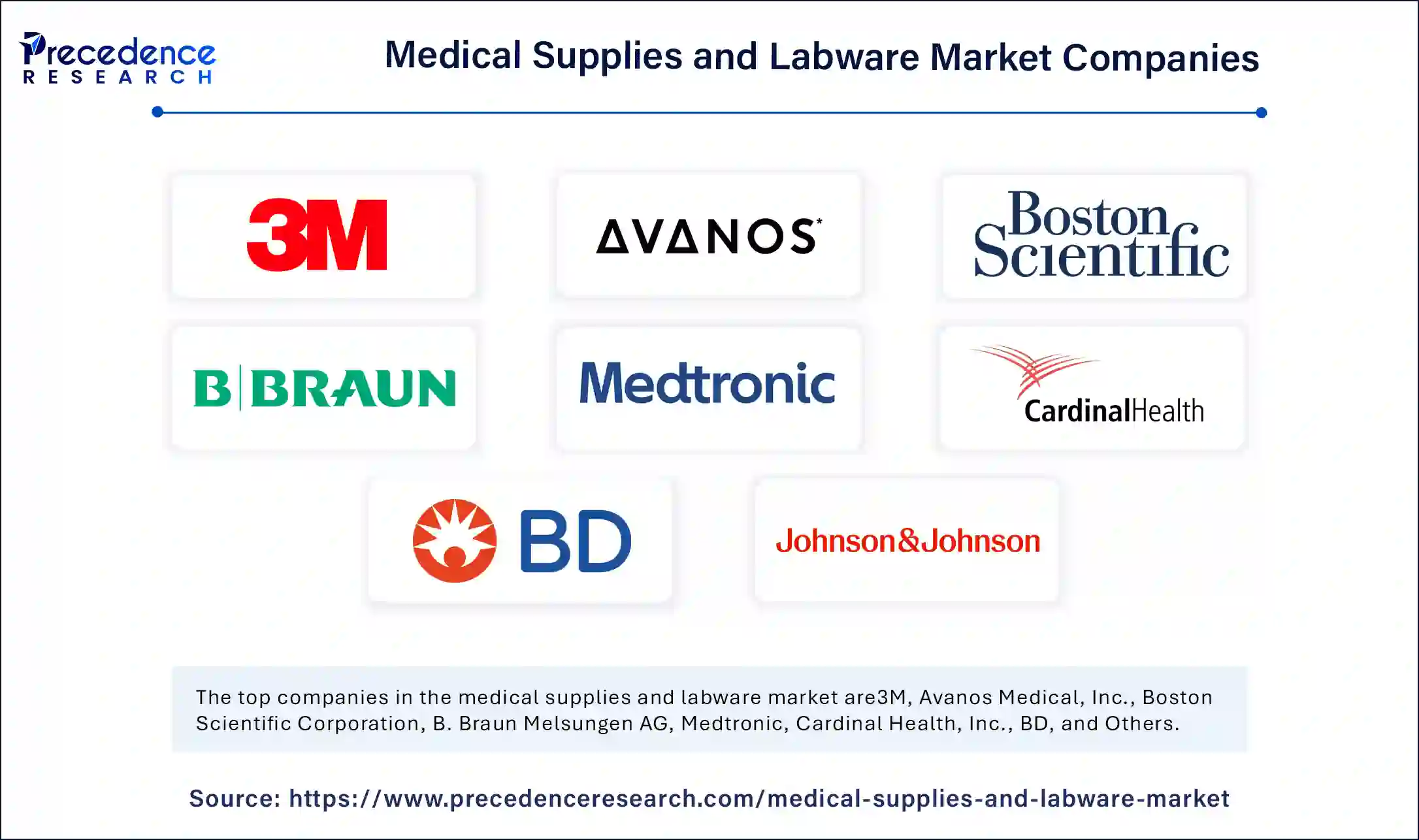
By Type
By Material
By Application
By End User
By Region
For inquiries regarding discounts, bulk purchases, or customization requests, please contact us at sales@precedenceresearch.com
No cookie-cutter, only authentic analysis – take the 1st step to become a Precedence Research client
January 2025
March 2025
August 2024
January 2025